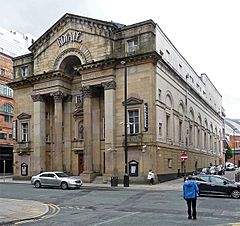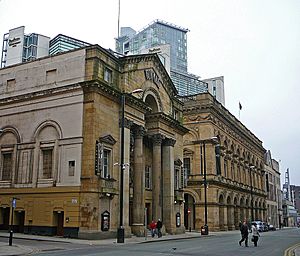Theatre Royal, Manchester facts for kids

Theatre Royal front façade
|
|
| Address | Peter Street, M2 3NQ Manchester England |
|---|---|
| Coordinates | 53°28′40″N 2°14′47″W / 53.4777°N 2.2465°W |
| Owner | Edwardian London |
| Type | Victorian variety theatre |
| Construction | |
| Opened | 1845 |
| Reopened | 1875, 1921, 1963, 1972, 1990 |
| Years active | 1845–1921 (as a theatre) |
| Architect |
|
|
Listed Building – Grade II
|
|
| Official name: Royale Club | |
| Designated: | 2 October 1974 |
| Reference #: | 1246667 |
The Theatre Royal in Manchester, England, first opened its doors in 1845. It stands right next to the Free Trade Hall. This makes it the oldest theatre still standing in Manchester today. A businessman from Manchester named John Knowles wanted a new theatre for the city, so he had it built.
The Theatre Royal worked as a theatre from 1845 until 1921. It closed because other new theatres, like the Palace Theatre and Opera House, became more popular. Since then, the building has been changed many times. It has been a cinema, a bingo hall, and even a nightclub. The building has been empty since 2011. The nightclub had its last night on December 31, 2010.
In 2012, a company called Edwardian Hotels bought the building. They also own the Radisson Edwardian hotel nearby. The Theatres Trust has put the Theatre Royal on its "At Risk" list. This means the building is important but needs care. As of 2023, no work has started, and Edwardian Hotels does not plan to fix up this historic building.
Contents
What Does the Theatre Royal Look Like?
The Theatre Royal is built from sandstone blocks. It has two main floors and a smaller attic level. The building was designed in the neoclassical style. This style uses ideas from ancient Greek and Roman buildings.
Around the building, between the top floor and the attic, there is a decorative border. This border has small blocks called modillions. The front of the building, facing Peter Street, is balanced and has three sections. The middle section is wider than the two on the sides.
Key Features of the Building's Design
The middle section of the front looks like a portico. This is a porch with columns. It has Corinthian columns and flat columns called pilasters. Above these, there is a decorative band called an entablature. This band has a round arch that goes up into the triangular roof part, called a gable.
Steps lead up to the entrances in each section. Above the main entrance, there is a special curved space called a pedimented niche. Inside this niche is a statue of William Shakespeare. This statue is based on one by Peter Scheemakers in Westminster Abbey. The side sections of the building have windows with balconies on the upper floor. Along the sides of the theatre, there are alternating rectangular windows and plain panels. Each window has a blank round arch above it.
Inside the Theatre Royal
The inside of the theatre has been changed over time. However, it still has its original balcony from 1875. The theatre was named a Grade II listed building on October 3, 1974. This means it is a very important historic building. Experts describe it as a "splendid classical composition in stone." They say it is one of the best examples of theatre architecture from the early 1800s in England. The Theatres Trust calls it "unique and architecturally significant." They also say its front is one of the best examples of theatre design from that time in Britain. They believe it even influenced the design of the Royal Opera House, London.
How the Theatre Royal Started
Manchester had two other Theatre Royals before this one was built in 1845. The first opened in Spring Gardens in 1775. It operated there until 1807.
The second Theatre Royal opened on Fountain Street in 1807. Sadly, it was destroyed by fire in 1844. John Knowles managed this second theatre before the fire. At that time, theatre in Manchester was not doing very well. Knowles created a strong group of actors, called a stock company. He proved to be a very skilled, though strict, theatre manager. After the 1844 fire, the owners of the Fountain Street theatre decided not to rebuild it.
John Knowles's Vision for a New Theatre
In July 1844, Knowles was honored at a public dinner. He received an award for his "energetic and successful efforts to revive national drama in Manchester." Knowles told everyone that if no one else would build a theatre, he would do it himself. So, Knowles bought the special rights needed to open a theatre. He then started looking for a place for his new building. Knowles loved theatre and wanted to bring back great plays to his hometown. He wanted to see classic plays performed in a way that truly honored them.
Knowles found a new spot for his theatre on Peter Street. He tore down an old inn and a horse market to make space. Knowles hired Francis Chester and John Gould Irwin as the architects for his new theatre. To prepare, Knowles and Chester visited many theatres in London. They studied their sizes, shapes, and how well their sound worked (acoustic capabilities).
Opening Night and Early Success
The new Theatre Royal cost £23,000 to build. It opened to an audience of 2,500 people. To prevent fires, a large tank was placed on the roof. It could hold 20,000 gallons of water. This water was connected by pipes to the stage and the green room (where actors relax).
On opening night, the show included music by Weber, a play called "Time works wonders," and a fancy ballet show. Knowles's schedule was very busy. In one season, there were 157 performances. Sometimes, two or three plays were performed in one night. The theatre became very popular. Famous people like Charles Dickens, John Leech, and George Cruikshank even appeared there.
The theatre was dedicated to William Shakespeare. Knowles placed a beautiful Carrara marble statue of the playwright above the entrance. It was considered Manchester's best outdoor statue. In 1875, after many successful years, Knowles sold the theatre to a company for £50,000.
What Happened After the Theatre Closed?
In 1921, the Theatre Royal was changed into a cinema. This happened because of the strong competition from the Palace Theatre and the Opera House. In 1972, the building became a bingo hall. Then, in 1978, it was turned into a nightclub. At this time, new lighting and equipment were added.
The nightclub had different names over the years. It was called "Discotheque Royale," then "Infinity" (starting in 2000), then "M2," and finally "Coliseum." The nightclub closed its doors in 2011.
Future Plans for the Building
In 2008, there was a plan for a very tall office and shop tower. It would have been 118 meters (387 feet) tall with 28 floors. This "Theatre Royal Tower" was designed to connect to the back of the old theatre.
In 2011, the owners at the time, Benmore, announced plans for a £2 million renovation. They wanted to turn the building into a live music venue. However, these plans to make it a hotel and music venue never happened.
Despite promises of investment, Benmore sold the building in November 2012. Edwardian Hotels bought it. They own the Radisson Blu Edwardian hotel next to the theatre in the Free Trade Hall. There is a chance the building could be restored as a theatre or a large hall for events. It could become an extension for the hotel.
As of December 2016, the building is still empty. The Edwardian Group is studying what they can do with it. The Theatres Trust has put the building on its "Theatre Buildings at Risk" list.
The outside of the building from 1845 is almost exactly the same. The balcony from 1875 is also still there. The Theatres Trust believes that the changes made inside for its past uses have hidden, rather than destroyed, the original interior. The Trust thinks the original inside of the building could be "restorable as a theatre."
See also
- Listed buildings in Manchester-M2


